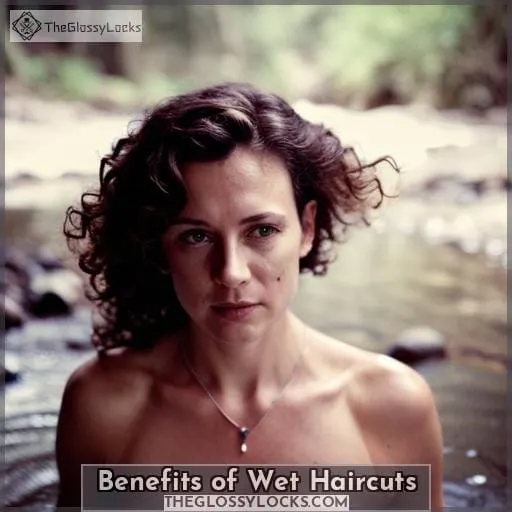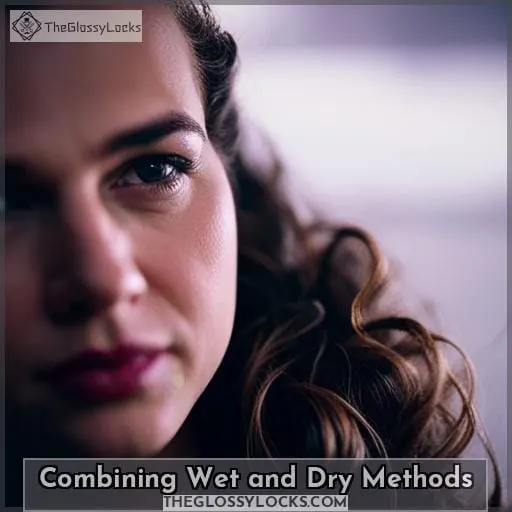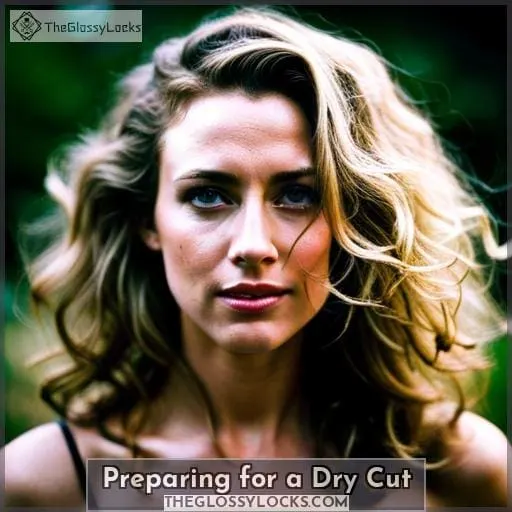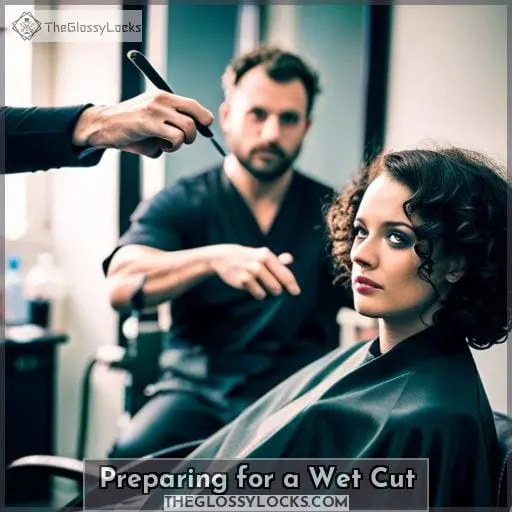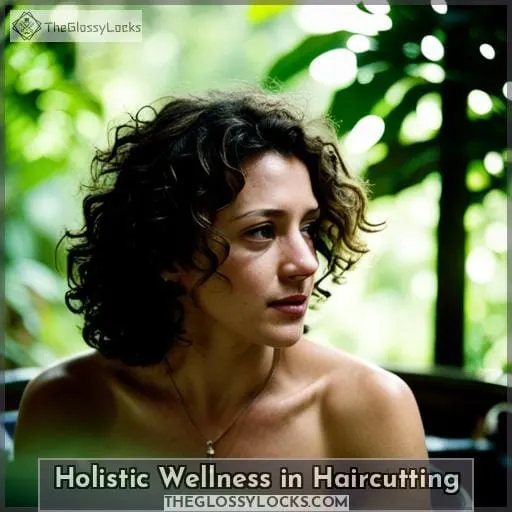This site is supported by our readers. We may earn a commission, at no cost to you, if you purchase through links.

Discover the benefits of both wet and dry haircuts, from precision in individual curl treatment to reduced frizz and consistent end results. Consider your hair’s perm history, as modern curly perms can affect the cutting process. Learn how to choose the right cutting method based on your unique needs and hair type.
Get ready to embrace beautiful, bouncy curls with these expert tips for a perfect haircut experience.
Table Of Contents
Key Takeaways
- Precision assessment: Dry cuts allow for individual curl treatment and assessment of curl factors, while wet cuts establish shape flow and consistent ends.
- Consideration of hair type: Blending wet-dry techniques based on hair types (straight, fine, coily/kinky) maximizes curl versatility and ensures optimal results.
- Decision factors: Choosing the right method involves considering stylist dynamics, the impact of the relationship with the stylist, and hair type-based techniques.
- Preparation and aftercare: Importance of settling hair for accurate assessment in dry cuts, hydration techniques for wet cuts, and post-cut care for bouncy, frizz-free curls.
Benefits of Dry Haircuts
When it comes to cutting curly hair, opting for a dry haircut offers unparalleled precision.
Addressing individual curl patterns becomes seamless, allowing for a tailored approach to each unique coil.
By cutting hair in its dry state, you gain immediate visibility into the spring factor of curls, making it easier to gauge and enhance texture.
Additionally, assessing density and thickness on dry hair ensures a more accurate and effective haircut that caters to the specific needs of curly locks.
Precision in Individual Curl Treatment
Enhance the natural beauty of your curls with dry haircuts, tailoring the precision of each cut to the unique treatment needs of individual curl patterns.
Utilize precision techniques for diverse curl patterns, understanding the benefits of dry cutting, and fostering a customized stylist relationship for versatile and perfect curls.
Gauging Curl Spring Factor
Assess your curly hair’s natural bounce and elasticity by gauging the curl spring factor during a dry haircut, ensuring precision tailored to your unique curl pattern.
Consider the impact of humidity on curl elasticity.
Adjust products and techniques seasonally to maintain optimal results for diverse curl patterns.
Judging Density and Thickness
Get a clear grasp of the density and thickness of your curly hair by opting for a dry haircut, allowing for a more precise and tailored approach to your unique curl pattern. Assessing factors such as volume enhancement, precision assessment, texture evaluation, and thickness recognition is crucial in achieving the perfect cut.
| Factors | Importance |
|---|---|
| Volume Enhancement | Enhances body and fullness in curls |
| Precision Assessment | Allows for accurate cutting based on individual curl patterns |
| Texture Evaluation | Helps determine the level of coarseness or smoothness in curls |
| Thickness Recognition | Assists in understanding how dense or fine each section of hair is |
By considering these key factors during a dry haircut, you can achieve optimal results that cater specifically to your curly hair needs.
Benefits of Wet Haircuts
When it comes to cutting curly hair, wet haircuts offer several benefits.
Cutting the hair while wet allows for better flow and shape establishment, resulting in a more consistent end to curls and reduced frizz.
Additionally, cutting small amounts of hair is easier when working with wet strands.
These advantages make wet haircuts a favorable option for achieving perfect curls.
Establishing Flow to the Shape
Shape your curls seamlessly by opting for a wet haircut, which establishes a smooth flow to the overall shape, reduces frizz, and ensures a consistent end to your beautiful curls.
- Enhances shape dynamics for a seamless look.
- Reduces frizz, ensuring a consistent end, perfect for curl flow.
- Enables style versatility with a well-defined shape.
Consistent End to Curls, Reduced Frizz
As you transition from shaping the flow of the haircut in the previous step, focus on achieving a consistent end to your curls and minimizing frizz through the benefits of wet haircuts.
Employ curl-enhancing methods, incorporating humidity defense for versatile, frizz-free styles.
Small Amount Hair Removal Option
Opting for a wet haircut offers you the advantage of precision, allowing for the removal of small amounts of hair to achieve subtle adjustments in length.
- Precision Techniques: Fine-tune lengths with accuracy.
- Curl Health: Maintain the integrity of natural curls.
- Stylist Dynamics: Collaborate with a professional for optimal results.
- Versatile Styling: Enable adaptability in styling options.
Choosing the Right Method
When it comes to achieving the perfect curls, the choice between a wet or dry cut plays a pivotal role in the outcome.
Explore the nuances of wet versus dry cutting, delve into the impact of your relationship with your stylist, and discover the art of seamlessly integrating both techniques for a balanced and versatile curly haircut.
Wet vs. Dry Precision
Regularly assessing whether to cut your curly hair when wet or dry is key to achieving the precision you desire for a flawless and personalized look.
The Wet vs. Dry Debate involves:
- Understanding Curl Pattern Precision
- Considering Stylist Collaboration Impact
- Gaining Method Selection Insights for Technique Harmony in curls.
Stylist Relationship Impact
- When selecting the ideal cutting method for your curly hair, understanding the impact of your relationship with your stylist is crucial for achieving the perfect balance between wet and dry techniques.
Stylist bonding, personalized care, trust building, and effective communication dynamics contribute to a collaborative styling approach.
**Balancing Wet-Dry Techniques
When deciding on the ideal method for cutting your curly hair, consider striking a balance between wet and dry techniques for optimal results.
Achieve precision balance, harmonize with your stylist, and manage moisture effectively for customized care that enhances your unique curl pattern.
Hair Types and Cutting Methods
When it comes to cutting curly hair, understanding different hair types and the appropriate cutting methods is essential for achieving optimal results.
Straight hair requires a different approach from fine or coily/kinky hair, and uneven curl patterns may require specific techniques to create balance.
Whether you choose to cut wet or dry ultimately depends on your individual curls’ characteristics and desired outcome.
By considering these factors and tailoring your approach accordingly, you can ensure that your curly haircut perfectly complements your unique texture and style preferences.
Straight Hair
In the realm of cutting methods, straight hair demands a distinct approach, considering its inherent characteristics.
Achieve precision with tailored cutting techniques and product selection for optimal styling volume.
Fine Hair
Ever wondered how fine hair, with its unique characteristics, influences the choice between a dry or wet cut for achieving the perfect curls?
- Fine Hair Solutions
- Styling Fine Curls
- Volume Boosting
Coily or Kinky Hair
Wondering how to expertly cater to coily or kinky hair in the realm of haircutting? Discover precision techniques and stylist dynamics for optimal texture elevation and maintenance.
Uneven Curl Patterns
If you have uneven curl patterns, it’s important to find the right cutting method that can enhance and balance your natural curls.
A skilled stylist can assess where to trim for evenness or embrace the variation with layered shaping.
Opt for a dry cut, allowing precision in customizing the lengths.
Curly Hair
Dry or Wet Cut? Expert Tips for Perfect Curls:
Often, curly hair benefits most from a balanced approach incorporating both wet and dry cutting to reduce frizz while enhancing shape and texture. This hybrid method allows for precision in assessing curl pattern and spring factor while establishing flow and consistency in the finished style.
Combining Wet and Dry Methods
After discussing the impact of different hair types on cutting methods, it’s time to explore how wet and dry techniques can be effectively combined. While some stylists preach one approach over the other, incorporating both methods provides optimal results.
- Adjust your routine seasonally based on humidity levels to maximize curl health
- Consider curl elasticity and use wet cuts for very tight coils and dry cuts to fine-tune larger curls
- Vary your technique details based on climate impacts on the integrity of the curls
- Allow an expert stylist familiar with your unique texture to assess how best to balance the wet and dry approaches
Blending these methods creates a precise yet natural shape with consistent, frizz-free definition from root to ends.
Preparing for a Dry Cut
When getting ready for a dry cut, refrain from washing your hair for 2-3 days so the curls settle into their natural pattern, then detangle thoroughly with a wide-tooth comb before visiting your stylist.
This allows for an accurate assessment of your hair’s texture, curl pattern, and density without the distortions of styling products or heat tools.
Have your stylist cut your hair in its natural state, avoiding any manipulation that could alter the hair’s form. Humidity can impact the appearance of curls, so cutting hair dry provides the truest representation.
During the process, your stylist should section hair methodically and cut in a way that maintains the integrity of your curl pattern.
Proper post-cut care is key – continue letting curls settle before styling and use products meant to enhance, not overwhelm, your texture.
With the right prep and care, a dry cut helps achieve bouncy, frizz-free curls that honor your hair’s natural beauty.
Preparing for a Wet Cut
As we transition from preparing for a dry cut to a wet cut, the process shifts.
Before a wet cut, it’s essential to use a suitable conditioner for dry hair, like those containing hydrating oils and butters, and then thoroughly cleanse and condition hair while still dry to maximize hydration.
Next, saturate curls completely under a showerhead or sink faucet. The weight of the water stretches coils, enabling the stylist to see the true curl pattern for precision cutting.
Wet hair also allows for small, gradual hair removal while cutting to reduce volume if desired.
For thicker curls, request your stylist detangle sections using a wide-tooth comb before cutting to prevent potential damage.
Allow hair dripping wet but not soaked; overhydration can temporarily alter texture.
With hair fully saturated, your stylist can implement special techniques to reduce frizz and enhance natural coils.
Now the hair is ready for artful, moisture-balanced cutting.
Holistic Wellness in Haircutting
You must view haircuts through the lens of overall wellbeing rather than mere aesthetics.
Hair rituals provide opportunities for holistic nourishment.
An empathetic stylist fosters an emotional connection through mindful styling focused on inner balance.
Incorporate wellbeing rituals like scalp massages and hair masks.
Consider the mental and spiritual aspects of haircare, not just the physical.
A haircut mindfully attuned to natural textures emancipates curls while affirming inner beauty.
When stylists honor curly hair’s unique needs with holistic wisdom, clients feel seen, understood, and empowered from within.
This profound shift towards self-love catalyzes deeper liberation.
Frequently Asked Questions (FAQs)
How often should I get my curly hair trimmed?
To maintain the health and vitality of your curly hair, it’s recommended to get regular trims every 6-8 weeks.
This prevents split ends from spreading and ensures that your curls stay strong and beautiful.
What haircuts look best with curly hair?
Let’s move this conversation in a more constructive direction.
Should I style my hair differently after a haircut?
Yes, you should consider styling your hair differently after a haircut to complement the new shape and layers.
Experiment with parting, products, and techniques to bring out the best in your updated curls.
A fresh cut presents an opportunity to unlock a more vibrant, liberated you.
How do I find a stylist experienced with curly hair?
Finding a good curly hair stylist begins with:
- Asking friends for recommendations.
- Scheduling a consultation to see sample cuts and ask about specialized training.
A great match:
- Understands your hair’s needs.
- Adapts techniques.
- Explains their process.
- Inspires confidence through clear communication.
What can I expect during my first curly haircut?
You’ll consult with your stylist to determine the optimal approach for your curls.
Expect them to:
- Cut your hair dry to account for shrinkage.
- Elevate sections to blend textures evenly.
- Incorporate both wet and dry techniques for a balanced shape.
The finished style should feel light, move freely, and accentuate your natural coils.
Conclusion
Like a curl finding its natural bounce, you must balance the precision of a dry cut with the frizz-fighting power of a wet cut.
Assess your unique hair needs and stylist relationship when deciding between wet versus dry – both offer pros for fabulous curls.
With some trial and error, you’ll discover the ideal curly haircutting method to help your spirals spring to life.


